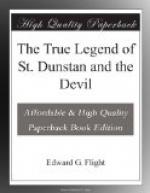Chiefly, however, is the happy change attributable to the discriminating and impartial judgment of the reading public of this golden Victorian era. In the present day, it may be considered a general rule, that no picture is admired, no book pronounced readable, no magazine or newspaper circulated, unless in each case it develope intrinsic merit. The mere name of the artist, or author, or editor, has not the slightest weight with our present intelligent, discriminating community, who are never enslaved, or misled, by whim, caprice, or fashion. It has been said, but it seems too monstrous for belief, that, formerly, persons were actually to be found so extremely indolent, or stupid, or timid, as never to think for themselves; but who followed with the crowd, like a swarm of bees, to the brazen tinkle of a mere name! Happily, the minds of the present age are far too active, enlightened, independent, and fearless, for degradation so unworthy. In our day, the professed wit hopes not for the homage of a laugh, on his “only asking for the mustard;” the artist no longer trusts to his signature on the canvas for its being admired; no amount of previous authorship-celebrity preserves a book from the trunkmaker; and the newspaper-writer cannot expect an extensive sale, unless his leaders equal, at least, the frothy head of “Barclay’s porter,” or possess the Attic salt of “Fortnum and Mason’s hams.” At the same time, the proudest notable in literature can now no longer swamp, or thrust aside, his obscurer peers; nor is the humblest votive offering at the shrine of intellect, in danger, as formerly, from the hoofs of spurious priests, alike insensible to receive, and impotent to reflect or minister, light or warmth, from the sacred fire they pretend to cherish. In short, such is the pleasant change which has come over literary affairs, that, however apposite in past times, there is not, in the present, any fitness in the exclamation, “Oh, that mine enemy would write a book!”
With reference to the observation, made by more than one correspondent, that the horse-shoe has not always proved an infallible charm against the devil, the author, deferentially, begs to hazard an opinion that, in every one of such cases, the supposed failure may have resulted from an adoption of something else than the real shoe, as a protection. Once upon a time, a witness very sensibly accounted for the plaintiff’s horse having broken down. “’Twasn’t the hoss’s fault,” said he; “his plates was wore so thin and so smooth, that, if he’d been Hal Brook[1] his self, he couldn’t help slipping.”
[Footnote 1: Doubtless he meant Al Borak, the name of Mahomet’s night mare.]
“You mean,” said the judge, “that the horse, instead of shoes, had merely slippers?”
Peradventure, the alleged failures may be similarly accounted for; the party, in each case, having perhaps nailed up, not a shoe, but a slipper, the learned distinction respecting which was thus judicially recognised. The deed which the devil signed, must, like a penal statute, be construed strictly. It says nothing of a slipper; and it has been held by all our greatest lawyers, from Popham and Siderfin, down to Ambler and Walker, that a slipper is not a shoe.




